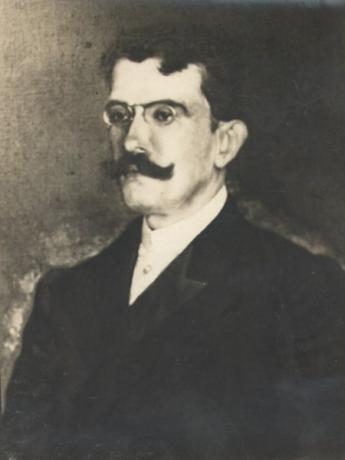Raul Pompeia was a Brazilian author of the 19th century, born on April 12, 1863. His best known novel is the athenaeum (1888). Some critics consider that this work has autobiographical traits, as the writer went through the experience of studying at a boarding school, the central space of this narrative. Thus, this naturalistic novel mainly explores the deterministic aspect of the medium in question.
In addition to being a novelist, the writer also practiced journalism and he positioned himself politically in favor of the government of Floriano Peixoto (1839-1895). This political posture of his, contrary to that of most writers of his time, caused a weariness in their relationships, which emotionally shook the author, who shot himself in the chest on December 25, 1895.
Read too: Júlia Lopes de Almeida – author associated with realism and naturalism
Biography of Raul Pompeia

Raul Pompeia was born on April 12, 1863, in Angra dos Reis, in the state of Rio de Janeiro. His father was a lawyer, a fact that influenced the author to study law. In 1867, his family moved to the city of Rio de Janeiro, where,
at the age of 11, the writer joined a boarding school, Colégio Abílio, owned by Baron of Macaúbas (1824-1891).Five years later, he went on to study at Pedro II College. Next year, in 1880 he published his first book — A tragedy in the Amazon. A student at the Largo de São Francisco Law School, in São Paulo, from 1881 onwards, he began to have problems with some of his professors, because showed up abolitionist and republican. Possibly because of this, he flunked his third year of college, but he appealed.
He ended up receiving another failure the following year, but he was not alone in this possible ideological persecution, other students also failed. The solution they found was to finish the course at the Recife Faculty of Law.
However, Raul Pompeia did not exercise the profession. In addition to having worked as a journalist, using, among others, the pseudonym Rapp, he became professor at the School of Fine Arts and also director of the National Library after proclamation of the Republic (1889).
Do not stop now... There's more after the advertising ;)
A year earlier, your romance the athenaeum it had been published, with critical success. However, at the beginning of the young republic, the writer decided to give support for the dictatorial government of Floriano Peixoto. Such a stance generated the enmity of olavo bilac (1865-1918), Sparrow Mallet (1864-1894) and Luís Murat (1861-1929), among others. The contenders used newspapers to trade offences.
So when Prudent of Morals (1841-1902) assumed the presidency, the author lost his post as director of the National Library. In this context of persecution and aggressive public statements, Pompeii decided to end her own life with a shot in the chest, at Christmas 1895, in Rio de Janeiro. However, he was honored by the Brazilian Academy of Letters when he was named patron of chair number 33.
Literary style by Raul Pompeia
Raul Pompeia was a writer belonging to naturalism Brazilian, therefore, his works have the following characteristics:
Objectivity
Determinism
Biology
Zoomorphization
sociopolitical criticism
scientism
anti-romanticism
Lack of idealizations
Thus, the characters are built on the basis of a objective, critical and (pseudo) scientific look. They have their lives determined by the environment in which they live, the race to which they belong and the historical moment in which they live. Furthermore, its biological characteristics outweigh its psychological elements. Thus, naturalistic characters approach animality (zoomorphization) and therefore are controlled by their instincts, to the detriment of reason.
Read too: Realism in Brazil – peculiarities of this aesthetic in Brazilian lands
Works by Raul Pompeia
![Cover of the book O Ateneu, by Raul Pompeia, published by Companhia das Letras. [1]](/f/71c36b43881d74885ac956b345123f92.jpg)
A tragedy in the Amazon (1880)
A defendant facing the future (1880)
songs without meter (1881)
The Crown Jewels (1882)
the athenaeum (1888)
Dead soul (1888)
Agony (1895)
the athenaeum
The romance the athenaeum is a representative of Brazilian naturalism. Published in 1888, the work is based on determinism, in particular, the influence of the environment on individuals. O author, therefore, chose the school environment as a space for analysis of collective behaviors. Thus, the narrator makes it clear that the “education” that inmates receive at the Ateneu goes beyond the formal curriculum.
The Athenaeum is a intern school that welcomes the children of the 19th century Rio elite. Its owner and director is Aristarco Argolo de Ramos, a “pedagogue”, who seeks to make his school a model of education. However, it is clear that his main interests are social position and money. Sergio will study at the Ateneu at the age of 11, a fact that coincides with the life of Raul Pompeia, who also entered a boarding school at the same age.
This led critics to consider the book as autobiographical and Sérgio, therefore, the alter ego of Pompeii. Just like the author's father, Sergio's father is the one who takes him to school. Sergio, in addition to being a character, is also the narrator of the story and intends to describe the Ateneu as a space for transition to adult life, where the protagonist is faced with the end of naivety and dreams of childhood.
Raul Pompeia's novel has similarities with another naturalist novel, that is, the tenement, in Aluisio Azevedo (1857-1913), published in 1890, therefore, two years after the athenaeum. If, in Azevedo's work, the tenement is the kinda corrupt; in Pompeii, it is the boarding school. If, nothe tenement, João Romão is the figure of the capitalist who wants to get rich at any cost, no.the athenaeum, Aristarchus fulfills this function. In fact, in both works, the corrupting means is, symbolically, destroyed by fire.
Until then, Sérgio shows his trajectory in high school, where he is, in practice, educated to live in society, as the Ateneu is nothing more than the representation of the corrupt society itself from that time. There is, therefore, the idea that "the strongest survive", the basis of capitalist ideology and imperialist of the nineteenth century. Sergio needs to prove, then, that he is worthy of the social position that his parents occupy.
Sergio meets Rebelo — a dedicated, protective, suspicious student who advises the protagonist to be careful. Being older than Sérgio, Rebelo is no longer naive and he knows the “moral dangers” that surround them. Sanches, on the other hand, has a “sticky tenderness” that, at first, bothers Sérgio. With this, the narrator wants to demonstrate that, instinctively, he perceived in Sanches a “threat”, that is, Sérgio has an instinctive aversion to homosexuality.
The character franc he is melancholy and has difficulty expressing himself. He does poorly in his studies, in addition to being the target of contempt of all, who consider him a bad influenceto Sergio. Still, the protagonist also suffers from the influence of Barreto — religious and superstitious, who “talked about death, about the other life, prayed a lot, had wooden fingers, bentinhos, [...]” — and about Bento Alves — a strong and courageous young man who becomes a kind of hero for Sergio, as it is capable of subduing an opponent and, because of that, it is respected by both students and teachers.
Upon entering high school, Sérgio is advised by Rebelo to defend himself, not to let himself be dominated by another student. So, the condemnation of homosexuality is another feature of naturalistic novels present also in the athenaeum. In addition, the work shows the instinct as a guide for human decisions, be it the sexual instinct, be it the survival instinct, in this case, of the stronger, as the death of the weak and melancholy Franco demonstrates.
Image credit
[1] Company of Letters (reproduction)
by Warley Souza
Literature teacher

